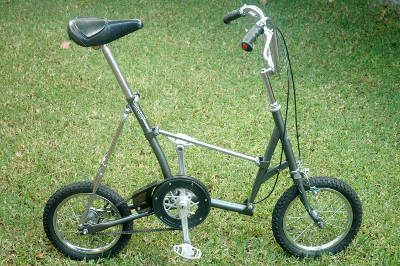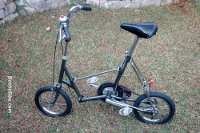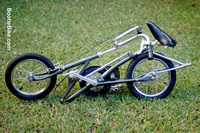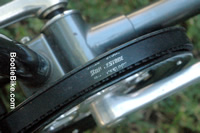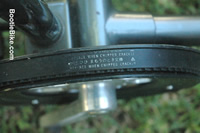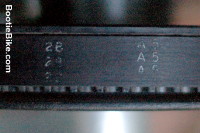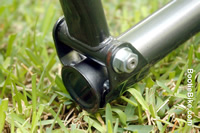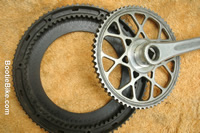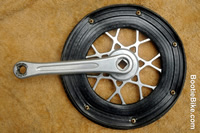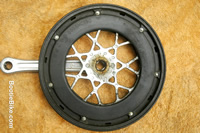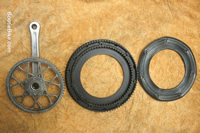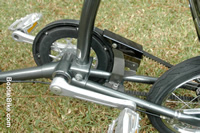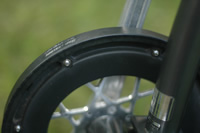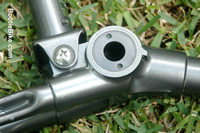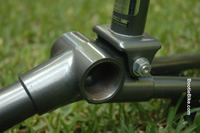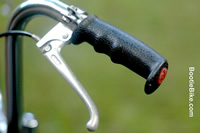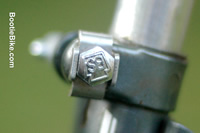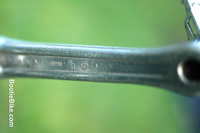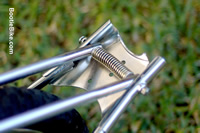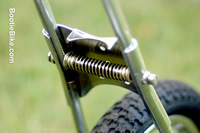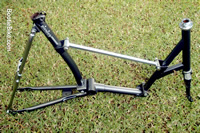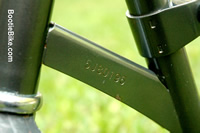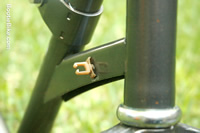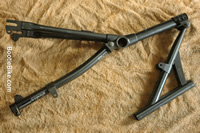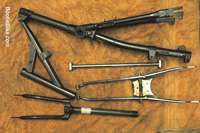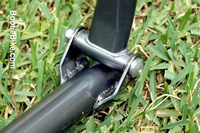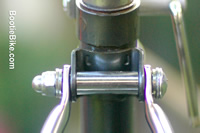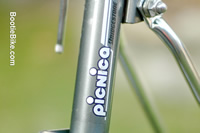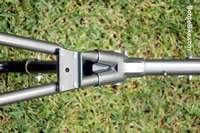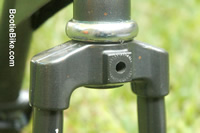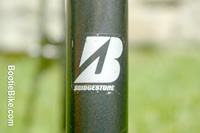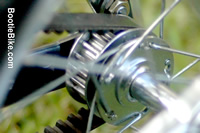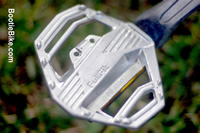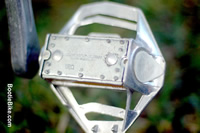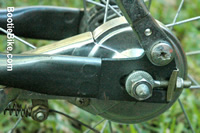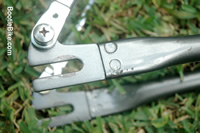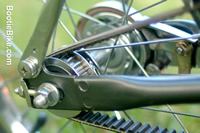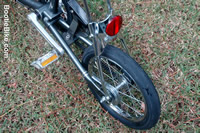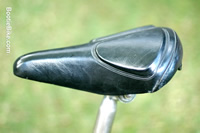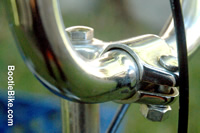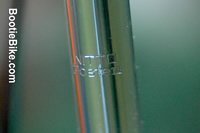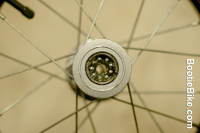1980s Bridgestone Picnica
The first belt drive bike
This zippy little bike, the Bridgestone Picnica, is the first belt drive bike. It was a mid-80s development of a chain drive model Bridgestone had been making for several years, and it turned an already funky, innovative little bike into a technological leader. The original had the world's easiest and quickest folding procedure; combine that with the 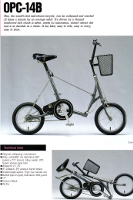 benefits of belt drive and you should have a world-beater. Does the belt drive Picnica really live up to that?
benefits of belt drive and you should have a world-beater. Does the belt drive Picnica really live up to that?
Let’s start by considering what the thing is supposed to do. Simply, a folding bike should get you around well enough, like any bike, but with the added benefit of being easy to store and carry. But to make a bike foldable one naturally pays a price, one way or another, and usually this means more cost, weight and all sorts of compromises that limit functionality. 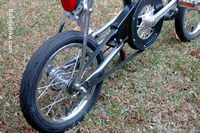 Those who design folding bikes aim to eliminate these drawbacks – one of the classic engineering challenges.
Those who design folding bikes aim to eliminate these drawbacks – one of the classic engineering challenges.
Well, the Picnica certainly has its quota of compromises. For a start, it’s only a single speed; while good for most hills, it's wearying over a distance. But I can accept that, as it suits the Picnica's limited mission in life. The frame is complicated and relatively heavy. And the bike is very small; fine for me, at 170cm, but riding it would be no picnic for those of bigger than average stature. The riding position is very upright, which can only be comfortable for a short distance, as all the rider’s weight is on his/her posterior. Compounding that are those tiny wheels (254 ETRTO), which transmit the smallest of bumps to the smallest of bums. And those tyres are an odd size too, so it’s hard to find decent quality replacements.
Easy to fold, but not very small
But these things don’t matter all that much, one might think; after all, it’s designed to be a portable folder, and we can accept such compromises in a bike that can be easily folded and carried and stashed almost anywhere.
Trouble is, the folded Picnica is neither particularly small nor easy to carry. The unfolded Picnica (did they really need to steal the name from Puch?) is about 1.2 metres long, and about a metre from the pavement to the top of the bars. Folded, it's about half the height, but a full 15 centimetres longer. For storage, unless you have somewhere to hang it up (this one lives hanging from the ceiling in a corner), you’ll be looking for a long, low space under a bench or somesuch. It's not suitable for taking on public transport, and if I want to put it in the back of my hatchback I need to fold down the back seat to make enough space for it. It would be a bit handier if one could hold or store it vertically (i.e. as a 'stick' folder), but unfortunately it can't be rested on the rear wheel, where most of the weight is, because the folded frame extends below it.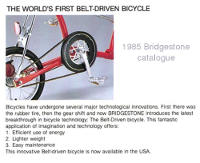
Is this a worthwhile result for all the complication and expense and compromise?
Right now you’re probably not alone in thinking the Bridgestone people went to a lot of trouble to do what could be done almost as well by any small-framed bike with lowered bars and seat post, such as the Le Petit Bi in the 1930s-40s, the Bootie in the 1960s and the Daewoo Shuttle in more recent years. And you may be reminded of the Raleigh RSW 16 Compact of the 1960s, which folded into a shape that was, well, sort of smaller. The joke at the time was that the RSW was the only bike that got bigger when folded.
The frame and cycle bits
Ok, so the fold is not that small, but it is at least easy and quick. And how does it work? Basically it's a case of the frame collapsing backwards on itself, with the handlebars and seat post falling to the top of the rear wheel. To this end the main part of the frame is a quadrilateral with a pivot at each corner, and a rear triangle made collapsible by hinged seat stays. It's those seat stays that hold everything in place. 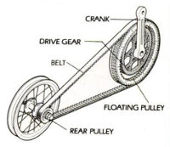 In the riding position they're straight and rigid, as on any bike. The upper part of each seat stay is locked in a retaining channel by spring pressure; squeeze the upper seat stays inwards and they pop out of their channels, and the hinge 'unlocks'. The upper and lower seat stays then
In the riding position they're straight and rigid, as on any bike. The upper part of each seat stay is locked in a retaining channel by spring pressure; squeeze the upper seat stays inwards and they pop out of their channels, and the hinge 'unlocks'. The upper and lower seat stays then fold over as the main frame folds – the whole bike collapses under its own weight. The reverse procedure is almost as fast.
fold over as the main frame folds – the whole bike collapses under its own weight. The reverse procedure is almost as fast.
Most of the cycle parts, and all of the frame pieces (and there are plenty of them), are made of steel, and it weighs over 13 kg. Of course, that's not heavy at all by Bootiebike standards, but this early 80s design looks newer than it is, and it's easy to forget it wasn't all that long ago that steel bits were the norm. These days we expect everything to be made of alloy and the complete bike to weigh next to nothing; on this bike the only alloy parts are the brake levers, the pedals (contenders for the world's ugliest, but they are comfy) and the crankset.
The belt drive
Naturally the crankset on this belt-drive bike, the first of its kind, is an original. But it’s more than just a conventional chainwheel modified to take a toothed belt. There is actually a chainwheel within a chainwheel. The internal chainwheel looks almost conventional, but with broader teeth. Fitting on it loosely is a black plastic outer chainwheel or, correctly, a floating pulley, with both internal and external teeth. The inner chainwheel works on the internal teeth of the floating pulley, while the external teeth of the floating pulley engage the drive belt.
The crankset is designed this way to allow the belt to operate at a low tension under low load (to prolong belt life and reduce friction losses) and with increased tension as the load increases (to prevent slippage). Looking at it, I couldn't understand how it works, but that's where the US magazine Popular Mechanics came to the rescue. As that august rag describes the 'Beltrex system': tension on the pedal drives the floating pulley forward, taking up belt slack and preventing slippage.
The benefits of the belt drive are cleanliness, little or no maintenance and quiet operation. It's all very civilised, and it makes chain drive seem every bit as olde worlde as it really is.
Riding the rebuilt Picnica
Test riding this newly rebuilt Picnica was a challenge. Instead of the usual squeaks and rattles there were mysterious rubbings and groanings from the transmission. Such is the joy of riding a rebuilt, highly unconventional bike that is 25 or 30 years old – how does one know what is normal and what is a problem? Anyway, since then I've put many happy kilometres on the Picnica and it's settled down nicely. 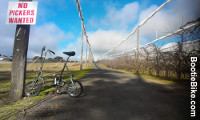 On steep hills, however, one is aware of a vibrato from the belt teeth engaging their counterparts on the floating pulley, and it can be felt through the pedals. A bit disconcerting at first, but all part of the package and far from spoiling what is a great advance in driveline technology. In fact the belt drive even in this, its earliest form, is so good I wonder why it hasn't become universal. It's just so good to forget about the hassles that go with chains.
On steep hills, however, one is aware of a vibrato from the belt teeth engaging their counterparts on the floating pulley, and it can be felt through the pedals. A bit disconcerting at first, but all part of the package and far from spoiling what is a great advance in driveline technology. In fact the belt drive even in this, its earliest form, is so good I wonder why it hasn't become universal. It's just so good to forget about the hassles that go with chains.
Arresting all that quiet, low maintenance propulsion is a steel, single pivot caliper brake up front and a contracting band brake on the rear, a first for BootieBike. The caliper works on a chromed steel rim, which doesn't bode well for wet weather performance (rim brake + chrome rim + rain = no braking). The band brake on the rear seems ok, but it occasionally expresses itself with a squeal of delight. I’ve curbed the worst of it by roughening up the friction band, but it still lets loose now and then, especially after coming to a complete stop. Of greater concern, I read that (and I haven't experienced it yet) once a band brake gets wet it won't work until it dries out. So it has a front brake that won't work in the wet, and a rear brake that won't work in the wet – and stays that way. I suppose if the brakes are no good in the wet, then the lack of mudguards is of no consequence (the earlier chain drive Picnicas had them). It seems all-weather use was not a priority for the belt drive Bridgestone.
Considering some of the harsh words above, one could get the impression I think little of this little bike. On the contrary, and despite all the above, I rather like it, even if only for shortish trips on dry days. The Picnica's fold, the quickest in the business, is disappointing because it's not very small or as convenient to handle as many other portables; at least the unfolded bike is easy to store, even if only because it is so small to begin with. Bridgestone marketed the belt drive Picnica as a fun bike: easy to ride, easy to carry and easy to store. They nailed the first bit, and the rest, well, maybe. But it is pleasant to ride and low maintenance, and it still looks funky and as modern as tomorrow. I think many buyers would have been very pleased with their Picnica, despite its failings. I am.

